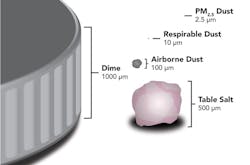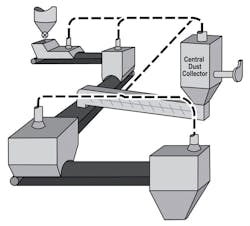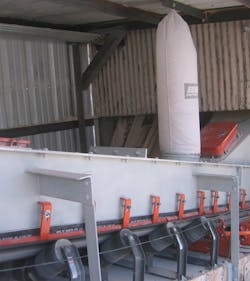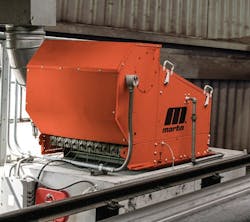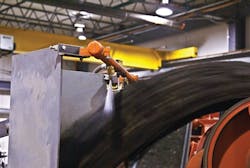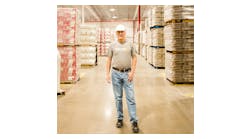Dust management for conveying powdered materials
Fugitive dust is an ongoing issue faced by most conveyor operators working with fine or powdered material. With raised awareness spurred by tighter regulatory standards, effective dust management has become an increasingly important challenge, motivating operators to employ efficient, cost-effective methods of particle management.
Depending on the source and ambient conditions, airborne dust can contribute to potential health or safety hazards, environmental issues, regulatory challenges, explosion risks, higher equipment maintenance costs and poor community relations. Dust inhaled by workers or members of the surrounding community can irritate bronchial airways and exacerbate existing lung conditions. Complaints about fugitive dust from nearby residents and businesses can also endanger future operating permits.
Significant amounts of dust can lead to frequent maintenance and faster equipment wear. Further, more cleaning can increase the amount of labor needed to maintain a safe work environment, placing staff near moving conveyors and other process equipment, resulting in a higher risk of injury. Together, these factors can have a significant impact on the cost of operation.
Because of the varying types and diversity of dust control methods, powder and fine material handlers should consider evaluating causes, problem areas, dust-generating processes and potential cargo management techniques to arrive at the optimum approach for their operation.
Most respirable dust particles are too small to see.
What is “dust”?
Categorized as either respirable or inhalable according to particle size, dry, solid dust particles range from about 1 to 100 microns (μm) in diameter. According to the U.S. Environmental Protection Agency, inhalable dust particles (larger than 10 μm) are typically caught by the nose, throat or upper respiratory tract. In contrast, respirable dust particles (under 10 μm) have the potential to penetrate beyond the body’s natural cleaning mechanisms, (cilia and mucous membranes) traveling deep into the lungs where they are likely to be retained.
Central dust collection system
Sources of dust in bulk handling
Virtually any activity that disturbs bulk material is likely to generate dust; however, crushed, fine and powdered substances pose a unique problem. Bulk conveying operations and trucks or railcars dumping loads of raw material often struggle to manage this fugitive material, as well as any activity involving heavy loading equipment.
Because they move large amounts of material at high speeds, conveyors can be a complex source of fugitive material. Transfer points composed of drop chutes, impact points and conveyor enclosures are notorious dust sources unless properly designed, installed and sealed. In fact, with today’s larger, faster conveyor systems, virtually the entire belt path can be a contributor to the release of dust.
Dust bags filter outgoing air to minimize fugitive material while reducing positive air pressure.
Dust management approaches: Containment, prevention or suppression?
Due to the significant number of complicated variables, which are constantly altered by changes in environment and materials, powder handlers implement a variety of process designs and plant layouts. Dust conditions and the methods of control are affected by production techniques and technologies, system options and equipment choices, as well as differences in conveyor design and construction.
Dust management efforts are generally based on one or more approaches, with many operations using a combination of methods to achieve maximum effectiveness:
- Contain the material and reduce, eliminate or control the air to let dust settle out
- Prevent the particles from becoming airborne by increasing their mass
- Collect, clean or suppress the airborne dust from the air
Material containment
Containment is the foundation of most good dust prevention processes and should be the first option considered. Keeping particles within the flow of the material prevents spillage and airborne dust from being released and requiring cleanup.
By controlling the drop height of the material, a less turbulent transition is created. Ideally optimized in the design stage of the conveyor system, structural drop height modifications on existing systems include additions such as hoods, spoons, deflector plates and rock boxes. These reduce the distance of the fall and the impact on the receiving belt.
Impact beds improve control over the material by flattening the impact zone of the conveyor and absorbing some of the drop force. Slider beds flatten the belt through the settling zone, allowing raised chute walls with external wear liners for installing and servicing without confined space entry. Wear liners and skirt seals ensure that the load remains on the conveyor.
These skirt seals (also known as apron seals) are installed along the belt edge to confine air and small particles to the transfer point enclosure. For extremely abrasive materials or high belt speeds, engineers have developed new skirt seal designs that extend performance and durability using standard 2-inch (50 mm) or massive 3-inch (75 mm) thick construction. Innovative swing arms enable its use on reversing belts as it rides gently on the belt, self-adjusting to maintain effective sealing, even as the belt path fluctuates and the sealing strip wears.
Prevention: Controlling air flow
Minimizing the height differences and providing material containment also assist in controlling the air flow within the transfer point. The flow of air entering and exiting the transfer point can be mitigated by avoiding drastic changes in material speed or trajectory.
Engineered flow chutes accomplish this by loading material in the same direction and speed as the receiving belt and confining the material stream, minimizing the disturbance in the material flow. The hood, located at the discharge of the loading conveyor, reduces the expansion of the material stream and deflects it downward. The spoon, located at the entry of the receiving conveyor, provides a curved loading chute that delivers a smooth transfer to allow the material to slide down to the receiving conveyor or vessel.
Good containment design with effective air flow control features an adequate dust settling zone of sufficient dimensions, with a belt that has been flattened and sealed to prevent material and air from escaping. Allowing the air to slow and the dust to settle requires an enclosure large enough for the air to expand and lose velocity. The height and width of the settling zone should provide the area necessary to decrease the air velocity to less than 200 ft/sec to minimize any dust pickup, with a chute long enough to allow time for the settling process to take effect. To improve the effectiveness of the containment, one or more dust curtains can be installed near the chute exit, with narrower curtains added intermittently within the stilling zone to create a circuitous path for the air to follow.
Dust bags provide a method of relieving positive air pressure within the system, while also filtering the dust and minimizing its escape. Often attached with a simple circular clamp to the rim of a port in the enclosure, the dust is captured inside, creating a filter cake. Dust bags are generally designed to collapse when the conveyor isn’t running, allowing filtered material to drop back onto the belt.
When necessary, air-cleaning systems (active control) like the central dust collector can also be used to filter the air and trap airborne particles. Installed in a central location and connected to the individual collection points by means of sealed ductwork, this type of filtration system would handle the dust extracted from the entire conveying system, collecting it for disposal or feeding it back into the process.
Central collectors utilize a blower to produce negative pressure, drawing air through the filter media. The blower is sized to manage the required airflow, while overcoming losses due to pressure drops across the system, including pressure losses in the ducts between the collector and the pickup points.
Although widely used in the past, central dust collection systems have several undesirable attributes, including:
- Buildup of material in the ducts causing operational and safety issues
- Potential explosion hazards from accumulated combustible material
- Large capital investments and high power usage
- Challenging maintenance issues, such as system-wide airflow balancing
- Manual maintenance may be required if material is not returned to the cargo flow
- The need to periodically empty the containment vessel of collected dust
An alternative is the integrated air cleaner. Containing only the blower and required filter media, this approach is designed to collect dust at the source by employing a series of smaller, independently operating units that pull air from the settling zone with a blower sized to remove the excess air from the enclosure. Unlike central systems, particles are not stored for disposal. Instead, they are trapped in the filter media, agglomerated into a filter cake, then discharged back into the material stream using a pulse cleaning system, which sends a short burst of air back through the filter to dislodge accumulated material. No ducting means less pressure drop, reducing overall power requirements and operating costs.
Chemical additives
Some technologies such as spray bars aimed at large-scale saturation using plain water may not be sufficient to effectively control the dust. To further enhance particle control, chemical formulations have been engineered to improve results.
Many dust control products offer some combination of wetting agents, binding agents and/or crusting agents to improve performance. Additives enhance the ability of the water droplet to combine with material particles, thus increasing the mass of the particles. Dust control additives also promote particle cohesion to improve the longevity of those bonds.
Modular elements configured to best suit the specific operating conditions and requirements of the individual process are important to manage the cost of operation. Water and dust control products should be applied with variable flow to maintain chemical-to-water ratios, while delivering independent control at multiple application points. To protect operations from liquid spills or equipment damage due to system faults, the dust control products should also contain fail-safe mechanisms such as automatic or manual valves that shut off flow the moment excessive volumes are detected by monitors or visual inspection (flowing or pooling water).
Conclusion
Every conveying system has its unique characteristics. Users should examine the features, construction and trouble points of individual systems, without making general assumptions that could lead to unsatisfactory results.
Dust management should be an integral part of the material handling system, optimized to prevent fugitive dust by:
- Applying containment in the right places
- Applying controlled amounts of moisture to improve agglomeration
- Utilizing air cleaners when moisture is not an option or excess air is present
Major changes in moisture or alterations in the process or equipment (increasing belt speed or cargo volume, for example) can have dramatic consequences on dust management. Even minor changes in environment such as a change in the atmospheric humidity can impact performance and flow.
However, if an existing material handling system successfully manages dust and spillage upon installation, it should continue to work as long as the conditions stay relatively consistent and the equipment does not suffer wear or abuse that alters its performance.
Mark Strebel, division manager, came to Martin Engineering with nine years of experience as a test and results engineer, coal handling supervisor and operations supervisor with a coal-fired public utility power plant. In his 20 years at Martin Engineering, he has focused on the development and application of technologies to improve bulk materials handling in the positions of R&D manager, conveyor products manager and product support manager. He is a co-author of FOUNDATIONS 4: The Practical Resource for Cleaner, Safer, More Productive Dust & Material Control (© 2009 Martin Engineering), and he is involved in updating the Dust Control Handbook for Industrial Minerals Mining and Processing (NIOSH). Strebel holds a Bachelor of Science in Mechanical Engineering and an MBA from Bradley University.

